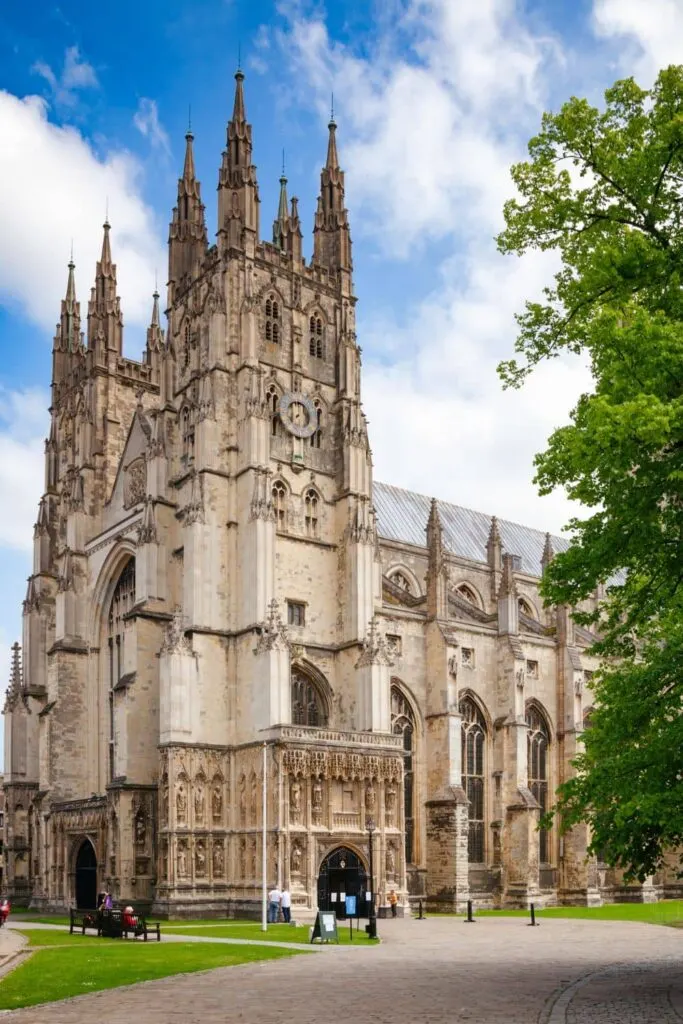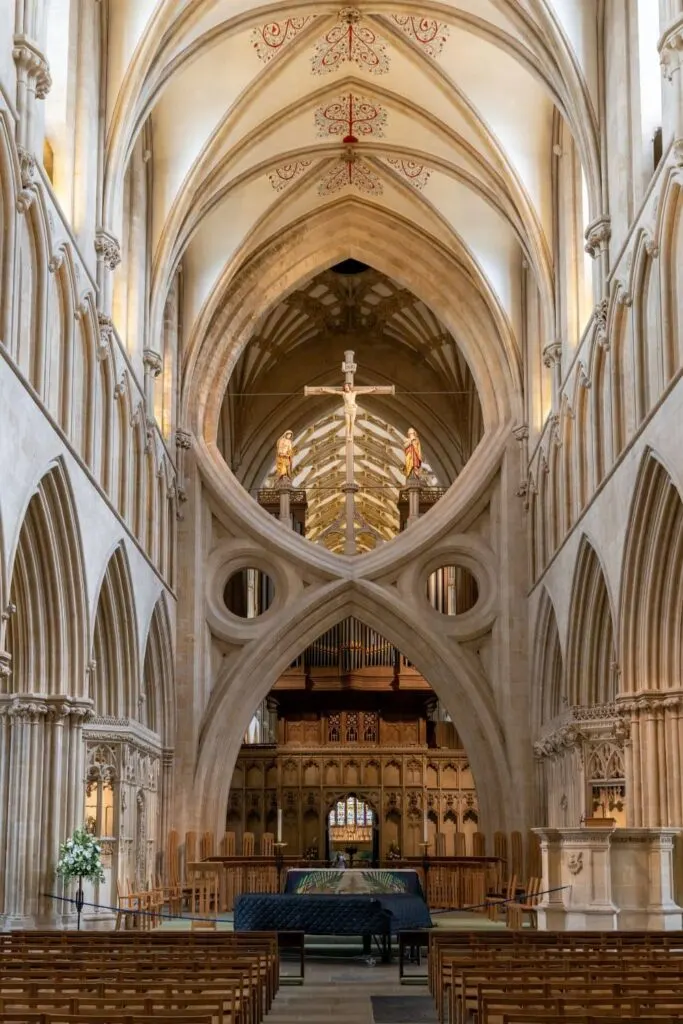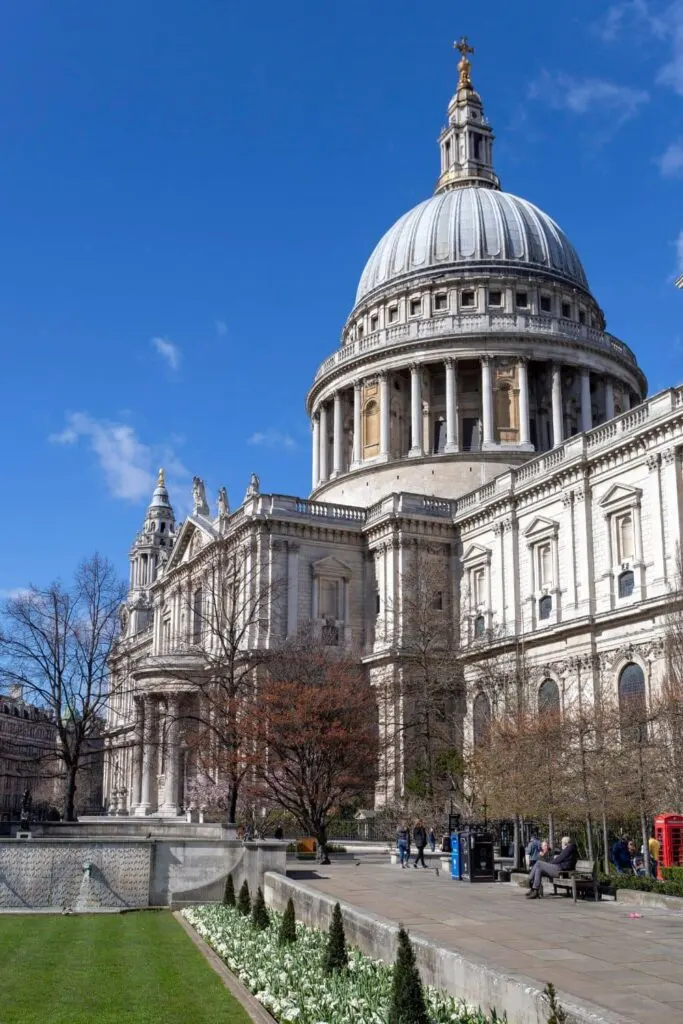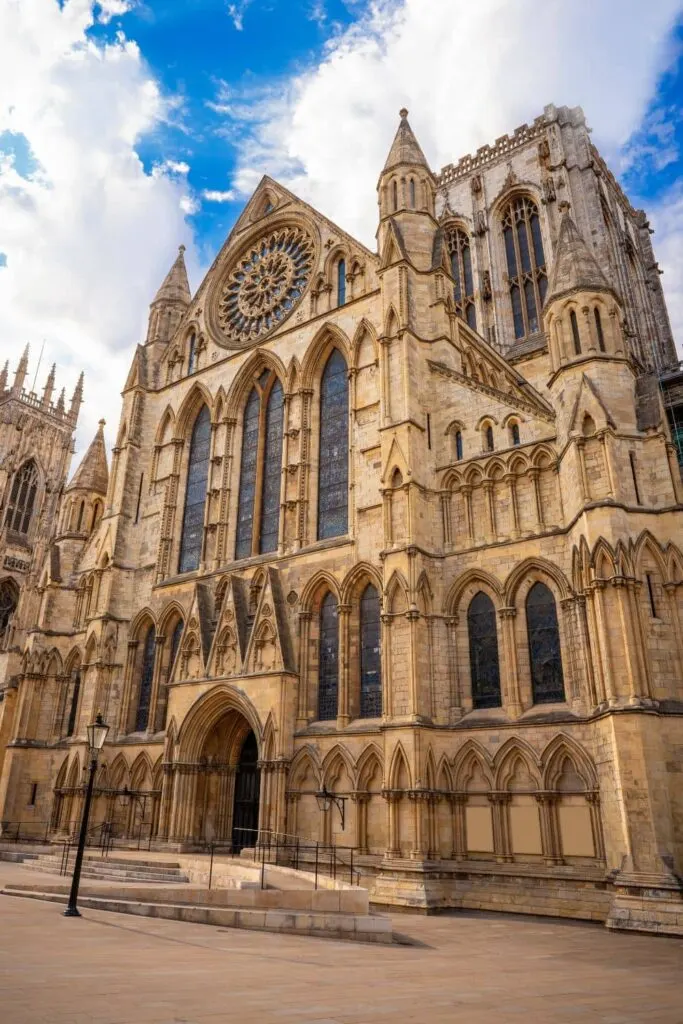
England contains 42 cathedrals of varying architecture, with some of the best, attracting millions of visitors a year. Not just a place of worship, their architectural styles document centuries of evolving history.
Two such structures, Canterbury Cathedral and Durham Cathedral, have become World Heritage Sites.
If you’re visiting England and want to explore the heritage of this ancient landscape, there’s no better place than its treasure trove of castles, ornate palaces, and centers of worship.
What Are Cathedrals?
England contains over 16,000 churches. However, the difference between a church and a cathedral is not defined by its size and architecture. While England’s best cathedrals are structures of beauty, they contain a “cathedra,” Latin for Bishop.
Since Bishops don’t run the cathedral but are responsible for an entire area, each significant region generally contains one cathedral. However, Liverpool is the exception to the rule, having two cathedrals within its city. Sometimes, Bishops upgrade churches to a cathedral.
Alternatively, if the bishop leaves, the title of cathedral goes too. An example of this is Westminster Abbey in London. It lost the title of cathedral in 1560, but was given the title “Royal Peculiar” as it serves the sovereign.
The process works the other way. Some structures were built as parish churches and later became cathedrals. Examples of this are Leicester Cathedral and Derby Cathedral.
During medieval times, most Bishops built English cathedrals from east to west, with high ceilings and long naves. They exemplify artistry with their ornate ceilings, stained-glass windows, intricate carvings, and attention to detail.
Many were initially built to a smaller scale. However, through history, numerous cathedrals underwent expansions, adding to their grandness.
Having visited many cathedrals in England, I’m always in awe that they were built without modern-day machinery.
The architectural details aren’t confined to just eye level. Look up high, and the stunning decoration extends into the vaulted ceilings and arched windows. During medieval times, clergy lit cathedrals with candles.
Due to the dim lighting, much of this extraordinary beautiful would have gone unnoticed. Today, we can appreciate the marvelous architecture by viewing these ten best cathedrals in England, in no particular order.
1. Gloucester Cathedral
- Location: 12 College Green, Gloucester | Open: Mon to Sat 10 am to 5 pm, Sun 12 pm to 5 pm | Cost: Free, but they appreciate donations
Gloucester Cathedral’s beginnings started in the 670s. However, the present-day building was constructed by Abbot Serlo in the late 1060s. Once an abbey, King Henry VIII’s dissolution of the monasteries in 1540 made this structure the stunning Gloucester Cathedral seen today.
The cathedral has undergone many reconstructions and restorations. Its most recent, the addition of solar panels on the Nave’s roof, reduces energy costs by 25 percent.

It’s free to visit the cathedral, although the cathedral welcomes donations to help pay for the expensive upkeep. For many, Gloucester Cathedral’s appeal comes from having the best cloisters in England. A marvel in engineering, the elaborate fan ceilings are a photographer’s dream.
At certain times, light streaming through the stained glass windows in the Cloisters provides rainbow reflections on the Cotswold stone, which came from nearby Cotswold villages.
Some of the Harry Potter films featured the famous cloisters, so Potter fans flock here to see its famous filming location.
In 1216, the first coronation of Henry III took place at the cathedral. It later served as a resting place for many Bishops of Gloucester and other notable people.
Numerous ornate tombs include those of Edward II and Robert Curthose, the oldest son of William the Conqueror. Stand-out features in architecture include the Lady Chapel, the Great East Window, the ornate Gothic ceiling, and its famous Cloisters.

Consider combining your tour of the cathedral with a visit to Sudeley Castle and Gardens. Located in the town of Winchcombe, it’s just 18 miles northeast of Gloucester.
2. Canterbury Cathedral
- Location: Cathedral House, 11 The Precincts, Canterbury | Open: Mon to Sat 10 am to 4 pm, Sun 12:30 pm to 4 pm | Cost: GBP 14.00 adults, children (under 18 yrs.) are free with a paying adult
Located in Kent, known as the “Garden of England,” Canterbury Cathedral is one of Britain’s oldest and most visited cathedrals. Founded in 600 AD, its structure was made from imported Caen stone from France.
Globally, it’s renowned for being the Mother Church of the Anglican Communion and seat of the Archbishop of Canterbury. Unlike most places of worship, Canterbury Cathedral is set within its precinct with limited visibility from the outside.
Visitors must pay an entrance fee even to access its exterior. This UNESCO World Heritage Site attracts a million visitors yearly, who see the spot where Archbishop Thomas Beckett was murdered. The 1170 event resulted from a feud between Beckett and King Henry II in which Henry ordered his demise.

Touring the incredible cathedral, travelers discover its 1400 years of rich history and view its beautiful gothic architecture. In the 12th and 13th centuries, the cathedral underwent significant expansion and reconstruction in the Gothic architectural style.
The new additions included the choir, Trinity Chapel, Corona Chapel, and the magnificent stained glass windows. These changes transformed Canterbury Cathedral into one of the finest examples of English Gothic architecture.
The oldest part of the church, the Norman Crypt, is a must-see. In 1172, the cathedral suffered a devastating fire.
Subsequently, it had to be rebuilt and resulted in a shrine for the recently slain Archbishop Beckett. Within the Northwest Transept, the Martyrdom marks the site of Becket’s murder. At the same time, a single candle on the floor marks the spot of his shrine.
The highlights of Canterbury Cathedral include The Choir, Southwest Porch, Miracle Windows, Crypt, and Cathedral tombs.
Canterbury, Gloucester, Exeter and many other cathedrals can be found in picturesque England southern cities.
3. Wells Cathedral
- Location: Cathedral Green, Wells | Open: Mon to Sat 7 am to 4 pm, Sun 12 pm to 2 pm | Cost: Free, but they appreciate donations

The first Gothic cathedral to be built in England was Wells Cathedral. It’s located close to Weston-Super-Mare, one of England’s popular seaside towns.
When I saw its unique façade, it stood out from the rest. The West Front, which was completed in the 13th century, exemplifies magnificence with its detailed medieval statues.
Initially, it was construct as a Roman Catholic cathedral, but later became an Anglican one during the reign of King Henry VIII.
I found its shape unusual, almost box-like, without any peaks or towers. While most cathedrals have impressive doorways, the detail extends from the ground almost to the roof of the Wells structure.
The appearance is so jaw-dropping that it overpowers the entrance. Like many ancient buildings, this cathedral has succumbed to the elements, and only 300 of the original 400 statues have survived.
Inside, the beauty of the Somerset cathedral continues with its Gothic style scissor arches that draw the eye upward. One of the biggest attractions is the mechanical clock located in the north transept. Dating from the 14th century, historians believe it’s the second-oldest astronomical clock in Europe.

Another highlight is the Chapter House which draws visitors to see its 13th-century architecture. The octagonal shape room featured a central column with 32 ribs shooting outwards and down around beautiful stained-glass windows.
Carved heads with different expressions adorn the ribbed intersections at a lower level.
The cathedral offers an array of interesting tours. Apart from the full cathedral tour, you can tour the “high parts” and go behind the clock, take a library tour, or take a special interest walk to learn about its stained glass.
4. St. Paul’s Cathedral
- Location: St. Paul’s Churchyard, London | Open: Mon to Sat 12 pm to 4:30 pm, closed Sun | Cost: GBP 17.00 adults, GBP 7.20 children (6-17 yrs.), under 6 are free
Built on Ludgate Hill, the highest point of the city, St. Paul’s Cathedral dominates London’s skyline. Travelers to England’s capital can easily spot its iconic white dome from many vantage points. St. Paul’s Cathedral is one of England’s largest cathedrals.
Should you only be staying in London, it’s the best cathedral to see in England without the need to travel. Built in 1675 by renowned architect Sir Christopher Wren, its design combines Gothic, Baroque, and Neoclassical elements.
While every nook and cranny of this grand cathedral delights visitors, the pinnacle of the tour is seeing the dome. It takes 528 steps to reach the third level of the dome.

While I struggled with the climb, I was rewarded with spectacular views of the cathedral’s interior and panoramic vistas of London.
Below ground, visitors can view the resting places of notable individuals in the Crypt. These include the tombs of the Duke of Wellington, Admiral Nelson, and Sir Christopher Wren.
Included in your admission is a film presentation in the Crypt. The 270-degree documentary features the history of St. Paul’s Cathedral, from its architecture to the Blitz and Great Fire of London.
St. Paul’s Cathedral provided the center stage for the royal wedding of Prince Charles to Lady Diana Spencer in 1981. It also hosted the funerals of Winston Churchill and Margaret Thatcher.
Also in Westminster, you’ll find the impressive Westminster Abbey (once a cathedral) near the House of Parliament and Big Ben.
5. Norwich Cathedral
- Location: 65 The Close, Norwich | Open: Daily 7:30 am to 6:30 pm | Cost: Free, but they appreciate donations
Norwich Cathedral dominates the city skyline with the second tallest spire, at 315 feet. I found this cathedral grand in scale. It boasts England’s biggest monastic cloisters, one of the largest organs with 655 pipes, and has the most medieval roof bosses globally.
Founded in the 11th century, the cathedral’s first Bishop, Herbert de Losinga, built the cathedral in the Romanesque style. Set on 44 acres, travelers can explore the structure for free, although the cathedral gratefully accepts donations to aid in the upkeep.

Inside, look high where the ceiling’s ribs are at a cross-section. Here, an interesting cluster of carved bosses tells stories from the bible. The faces are all different and include musicians, kings, popes, noblemen, and peasants.
Their gestures vary, too, from the jovial to the terrifying. Over 1000 roof bosses decorate the cathedral and are said to be the biggest collection in the world.
Outside, a stone memorial marks the grave of Edith Cavell. During the First World War, Cavell helped over 200 soldiers escape from Belgium. She was later captured, found guilty of a war crime, and sentenced to death. After the war, her body was returned to England for burial.
Recently, the cathedral has attracted visitors who come to see a peregrine falcon pair who call the spire their home. After the falcons arrived in 2009, the cathedral built a nesting platform with two webcams and an observation point in The Close.
So, no matter where you are, you can watch the nest without disturbing the birds.
6. Salisbury Cathedral
- Location: Salisbury, Wiltshire | Open: Mon to Sat 10:30 am to 4 pm | Cost: GBP 9.00 for adults, GBP 6.00 for students (13-18 yrs.), and under 13 are free
While Norwich has the second tallest spire, Salisbury boosts the highest at 404 feet. Constructed on an 80-acre Cathedral Close, the initial building dates from 1092.

However, the current cathedral dates from 1220. The iconic spire was added in the early 1300s, and visitors can marvel at its unique octagonal shape.
Visitors to the cathedral can admire the 1215 Magna Carta, a vital document symbolizing freedom and justice. While there are four remaining copies of the Magna Carta, Salisbury’s is the most well-preserved and registered with UNESCO.
Salisbury Cathedral has made the Guinness Book of Records for having the world’s oldest working clock. Dating from 1386, the wrought iron faceless clock strikes only on the hour.
In 1956, the clock underwent a complete restoration and is now on display in the north nave aisle.
Like Norwich Cathedral, the Salisbury spire houses a pair of peregrine falcons who nest there each summer. These birds of prey have become celebrities and even have a YouTube channel. As they grew, a conservation team named the chicks and rings their legs to track their whereabouts in future years.
If you plan to visit Salisbury Cathedral, consider the tower tour. The 90 minute tours take you high into the tower where you can explore the roof spaces and admire the views from the roof. While it takes 332 stairs to reach the roofline, it’s done in small stages.
7. Lincoln Cathedral
- Location: Minster Yard, Lincoln | Open: Mon to Sat 10 am to 4 pm, Sun 12 pm to 3 pm | Cost: GBP 9.00 adults, GBP 4:80 children (5-16 yrs.), and under 5 are free
Commissioned by William the Conqueror, Bishop Remigius de Fecamp started construction on Lincoln Cathedral in 1072. Twenty years later, and after Remigius’ death, the building was consecrated.

It’s the third-largest cathedral in England but does not lack the detail and charm of the smaller structures.
At the time of construction, it was the tallest building in the world. In 1311, the Bishop replaced the spire and, at 525 feet, became the world’s tallest spire. It retained that title until a storm destroyed it in 1548.
Throughout its history, the cathedral has had its share of tragedies. It suffered a great fire in 1124, and during an earthquake in 1185, the structure collapsed, leaving only the West Front. After the reconstruction, the tower collapsed in 1237 due to poor artistry.
One of Lincoln Cathedral’s oddities is the Lincoln Imp. As the legend goes, two evil imps came to the cathedral and damaged some of its interior furnishings.
An angel from the Angel Choir asked them to stop. One continued the rampage, so the angel turned it to stone. Today, the stone imp sits on a column in the Angel Choir.
Like other cathedrals, Lincoln contains some beautiful stained-glass windows. Two, in particular, the Dean’s Eye and Bishop’s Eye, are fine examples of Rose Windows, named because of their circular shape.
The cathedral offers additional tours for a fee of GBP 7.50. Two of interest include a climb of 300 stairs to the top of the central tower and a roof tour to explore the rafters and enjoy the views across the city.
8. Winchester Cathedral
- Location: 9 The Cl, Winchester, Hampshire | Open: Mon to Sat 9 am to 5 pm, Sun 12 pm to 3 pm | Cost: GBP 9.50
The darling of Winchester, its spectacular cathedral boasts of being one of the largest in Europe. The initial cathedral was built in 662, and its foundation is visible north of the present-day structure.

In the late 11th century, the Bishop constructed a larger building nearby, but the marshy land resulted in frequent Crypt flooding. The cathedral underwent a major reconstruction by Bishop Wykeham in the late 1300s, transforming it from Norman to Gothic.
When I walked through its doors, its immense size captivated me. At 295 feet (90 m) long, it has the longest nave in Europe. With such a lengthy nave, the heart of the cathedral houses twelve bays.
At 78 feet (24 m) high, the nave isn’t the highest or the best, but this English cathedral takes your breath away with its cavernous feel.
Winchester Cathedral is the resting place of a famous writer, Jane Austen. The novelist lived a quiet life in Winchester, writing many novels and publishing them anonymously. Visitors can view her memorial in the north nave aisle.
One of the prized items at Winchester Cathedral is the 800-year-old Winchester Bible. Known as the largest 12th-century bible in England, arguably, it may be the best too.
The 1160 manuscript features four volumes of writing and illustrations documenting medieval art. The volumes were written over thirty years, but sadly, the bible was never finished.
9. York Minster
- Location: Deangate, York | Open: Mon to Sat 10 am to 3:45 pm, Sun 12:30 pm to 3:15 pm | Cost: GBP 12.00 adults, GBP 9.00 students, children (16 yrs. and under) free with a paying adult
Since the 7th century, York has been a center of worship, having built several churches before the present-day cathedral. Known as York Minster, its official title is Cathedral and Metropolitical Church of St Peter in York. York Minster is the best cathedral to visit in Northern England.
During the Anglo-Saxon period, churches gained the title “Minster” if they were missionary teaching churches. Today, the York Cathedral still retains the honorary title.

Each year, visitors travel to York Minster to admire the largest Gothic cathedral in northern Europe. Given its size, the structure’s construction spanned 250 years, from 1220 to 1472.
Throughout its history, it has seen its share of tragedy, suffering a few fires and once hit by lightning. The last fire was due to a lightning strike in 1984. It caused a massive fire and the collapse of its roof.
During the reconstruction, the kids’ show, Blue Peter, invited children to design some of the new roof bosses. The Rose Window cracked in thousands of places from the fire’s heat. But since the leading kept it together, the cathedral successfully restored it.
Additionally, York Minster houses England’s largest medieval stained-glass window. Created in the early 1400s, the Great East window measures 32 by 77 feet and contains 311 panels. In 2018, the cathedral completed a ten-year restoration of the window.
The glaziers painstakingly removed each panel and conserved them with UV external glazing. In all, York Minster has 128 stained-glass windows containing two million pieces of glass. That alone is an excellent reason to visit this York Cathedral.
10. Ely Cathedral
- Location: Chapter House, The College, Ely | Open: Mon to Sat 10 am to 4 pm, Sun 1 pm to 3:30 pm | Cost: GBP 8.00 adults, children (under 16) free with a paying adult

Perched high on the Fens and often called the “Ship of the Fens,” a visit to Ely Cathedral does not disappoint. Initially built as a monastery in 673 by Etheldreda, daughter of a Saxon king, the church became a cathedral in 1109. During the 11th century, Abbot Simeon oversaw the present-day cathedral.
Ely’s claim to fame is its unique lantern tower in the shape of an octagon. Constructed from wood instead of stone, visitors can admire the spectacular vaulted ceiling painted in jewel tones.
During a visit to the cathedral, guests can climb the 170 steps to the top of the tower and enjoy panoramic views.
Like the lantern tower, the long nave features a vaulted ceiling with painted panels. The incredible panels depict the creation of man to Christ in glory. It’s a stark contrast to the ceiling ribs and carved bosses seen in other British cathedrals.

Another stand-out feature is the Lady Chapel, the largest of its kind in England. Its interior takes your breath away, although sadly, much of its original features are destroyed.
During the Reformation, vandals beheaded and vandalized many of the carved figures. Today, visitors can only ponder its magnificence during its prime.
Final Thoughts
While England is blessed with many beautiful cathedrals and medieval structures, they all cost a sizable amount to restore and upkeep. Without entrance fees and donations, these medieval cathedrals and castles become abandoned ruins.
Even if there is no entrance fee, consider donating to help preserve these places for our descendants.
Whether you visit Wells to see its stunning scissor arches, Ely to admire its unique lantern tower, or Salisbury to view the highest spire, each place has its appeal. In addition, the other 32 cathedrals are all magnificent structures worthy of a visit too.
Happy travels ~ Karen


